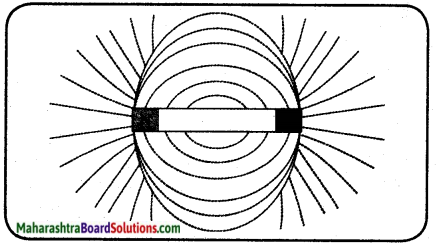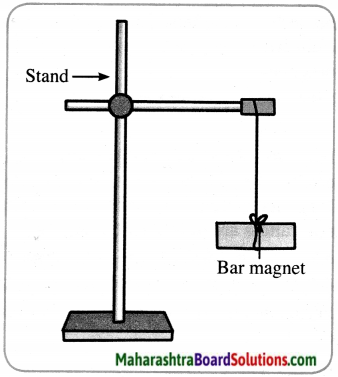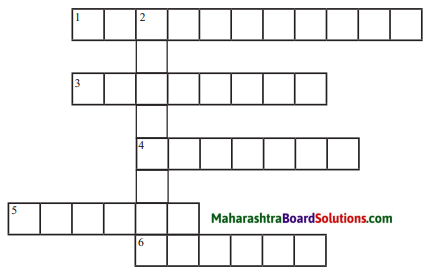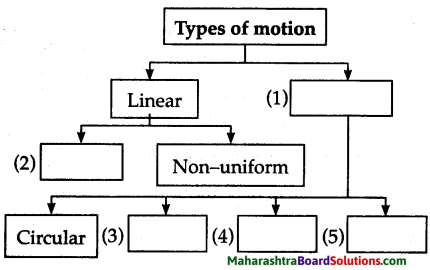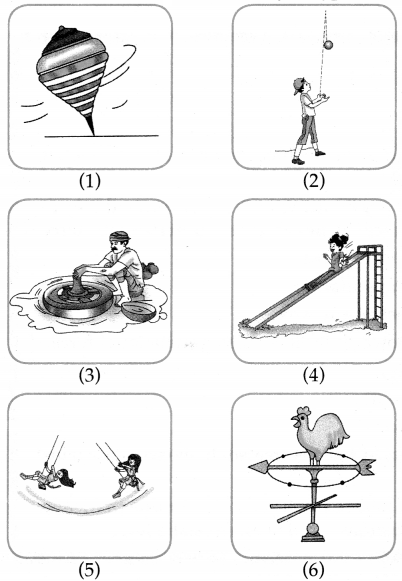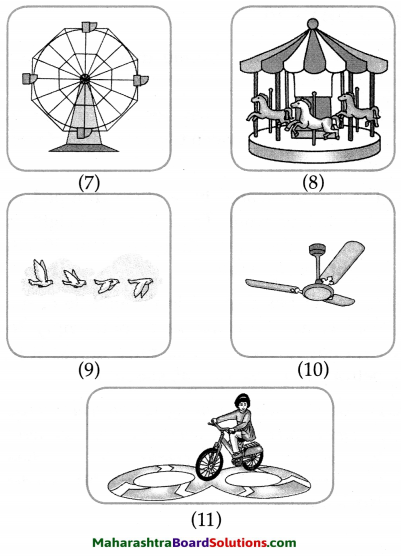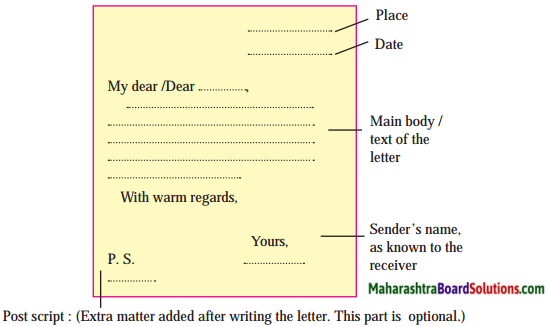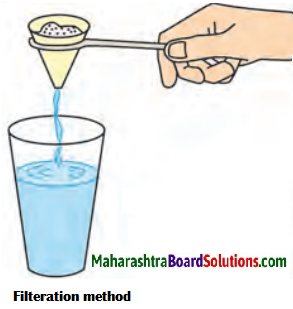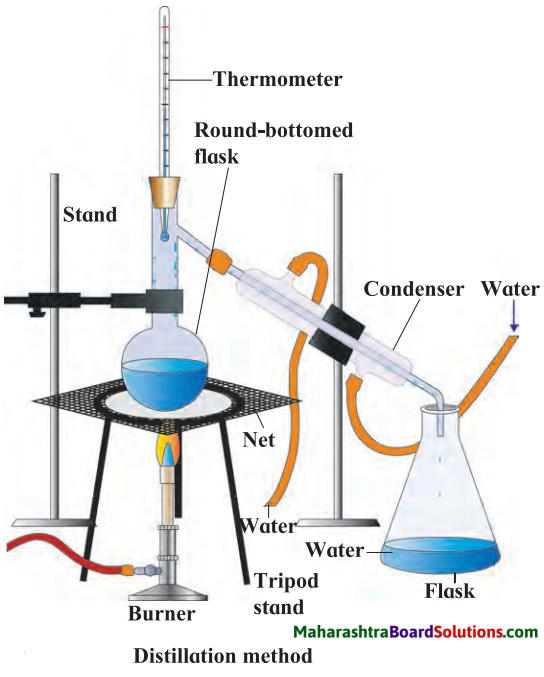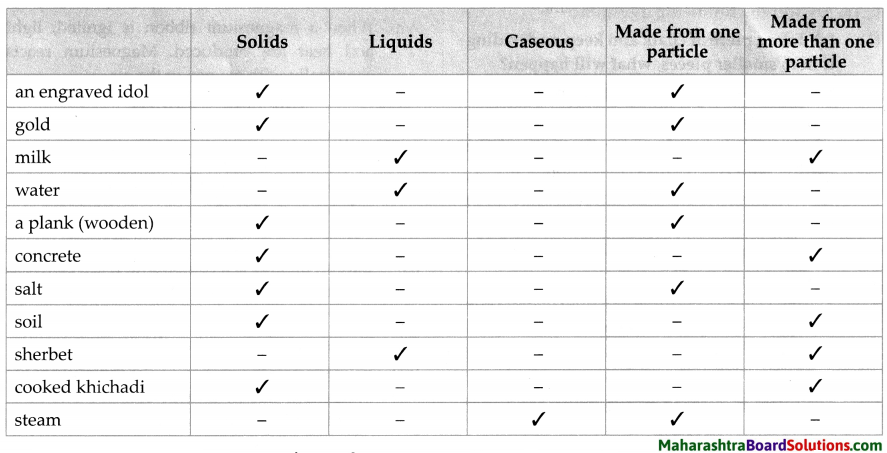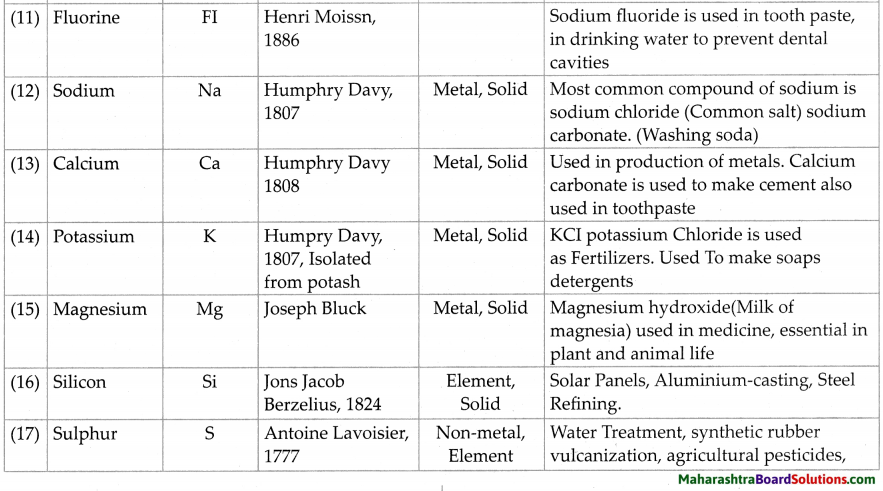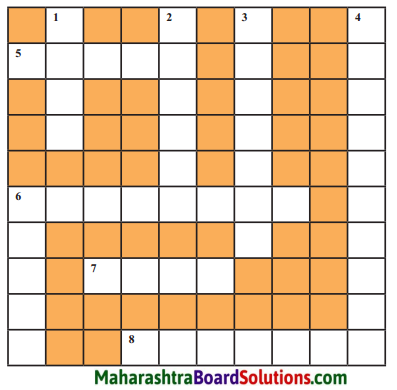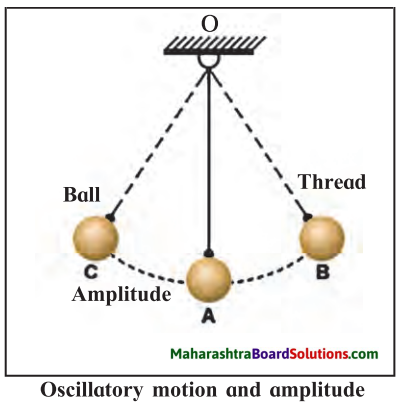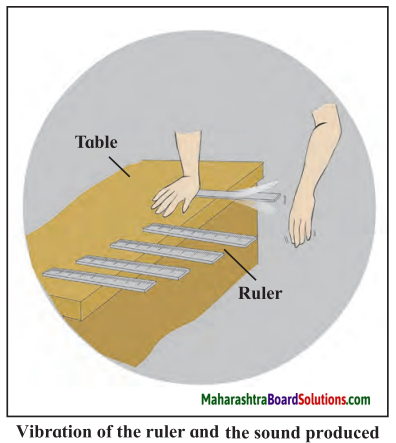Balbharti Maharashtra State Board Class 7 English Solutions Chapter 1.2 Odd One In Notes, Textbook Exercise Important Questions and Answers.
Maharashtra State Board Class 7 English Solutions Chapter 1.2 Odd One In
Class 7 English Chapter 1.2 Odd One In Textbook Questions and Answers
1. Read aloud the conversations in the story turn by turn.
Question 1.
Read aloud the conversations in the story turn by turn.
![]()
2. Write about Malti and Rima using the following points:
Question 1.
Write about Malti and Rima using the following points:
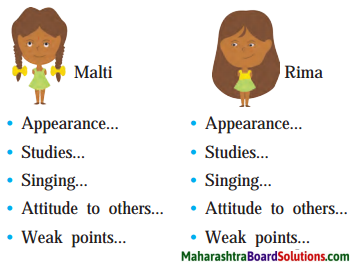
Use details from the story and your own imagination when you write the above descriptions.
Answer:
| Points | Rima | |
| Appearance | Simple, oily hair, long skirt | Stylish. |
| Studies | Studious, intelligent, scored well in studies. She was good at Maths. | She was also good in studies. |
| Singing | She had a melodious and well-trained voice. She wins the first prize in the Interhouse singing competition. | She was also good at singing and wins the first prize in her own category in the Interhouse singing competition. |
| Attitude Towards Others | Helpful and respectful. Ready to learn from others and improve. | Rude, arrogant, unkind behaviour. She didn’t like to be corrected. |
| Weak Points | Her English was poor. | She was weak in Hindi. She was jealous of others and thought others to be inferior to her. |
![]()
3. Imagine you are Malti. Write any one event in the story from Malti’s point of view.
Question 1.
Imagine you are Malti. Write any one event in the story from Malti’s point of view.
Answer:
Yesterday, I was absent from school. I decided to ask Rima and other classmates about the lessons taught by teachers. As soon as I uttered “I wanted to aks you about English assignment”, Rima and her friends burst out laughing. At first I didn’t understand why they were laughing. Then Rima started mocking at me, repeating the word ‘aks’.
Other girls giggled and looked at me with contempt. I felt very bad but I requested Rima to teach me English as she was good in English and its pronunciation. But she told me rudely that as I belong to the countryside, I am incapable of speaking proper English. There was a lump in my throat as I could not bear this humiliation. I wanted to retort but I couldn’t find the right words. I burst into tears and decided to run away from there.
4. How do you behave with your classmates? Write about your attitude and behaviour in the appropriate column:
(Some actions: Ask others for help, Refuse help, Judge others by their appearance, Judge others by their accent)
Question 1.
How do you behave with your classmates? Write about your attitude and behaviour in the appropriate column:
(Some actions: Ask others for help, Refuse help, Judge others by their appearance, Judge others by their accent)
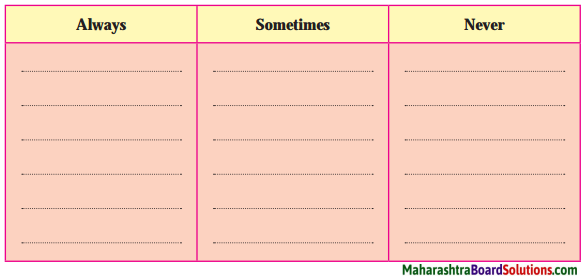
Answer:
| Always | Sometimes | Never |
| I help others. | I am sometimes grumpy towards my friends. | I am never judgemental. |
| I share my tiffin with my friends. | I enquire about the health of a sick classmate. | I never use harsh words. |
| I always respect others. | I sometimes visit NGO’s to volunteer. | I never misbehave in class. |
Note: Students do the exercise based on their own individual behaviour.
![]()
5. Talk about: (a) your strengths (b) your weaknesses (c) the changes that you would like lo see in yourself (3 each).
Question a.
Your strengths:
Answer:
My biggest strength is my willingness to learn and improve myself. I am very polite and humble. I am also a good listener due to which I make friends very easily.
Question b.
Your weaknesses:
Answer:
I am lazy when it comes to doing homework.
I have a phobia of speaking in front of a large group. This has developed into stage fright. I also can’t stop eating once I start. This makes me fall sick very often.
![]()
Question c.
The changes that you would like to see in yourself:
Answer:
I would like to get rid of my laziness. I want to start cultivating the habit of reading to improve my language. I would like to participate confidently in competitions. And lastly I want to control my diet for a healthy living.
6. Discuss: Is it necessary to develop a good accent? Why? What efforts can you take to improve your pronunciation? With your teacher’s help, find out how to use online dictionaries for the purpose.
Question 1.
Discuss: Is it necessary to develop a good accent? Why? What efforts can you take to improve your pronunciation? With your teacher’s help, find out how to use online dictionaries for the purpose.
Answer:
Yes, it is extremely necessary to develop a good accent because it aids in communication. A proper accent is important to understand and be understood. I can refer a dictionary that provides pronunciation key. I can also listen to news channels such as BBC that helps us to speak English the way the natives do. Besides, no matter what the language, avoiding the influence of mother tongue can help improve pronunciation.
7. list all the adverbs that end with ‘-ly’ from the passage.
Question 1.
list all the adverbs that end with ‘-ly’ from the passage.
Answer:
- quietly
- rudely
- cattily
- uncharitably
- sadly
- snidely
- abundantly
- readily
- cheerfully
- mercilessly
- particularly
- roundly
- badly
- stubbornly
![]()
8. Language Study:
Question 1.
Types of nouns: You know that a noun is a word used as the name of a person, place or thing. The names given to particular persons, places, animals etc. are proper nouns and the rest are common nouns. For example, ‘Ria’ is a proper noun, because it is the name of a particular person. But, ‘girl’ Is a common noun, as It is not the name of a particular person. ‘Ahmednagar’ Is a proper noun, because it is the name of a particular place. ‘Town’ Is a common noun, because it is not the name of a particular place.
Answer:

Write at least 5 common nouns and 5 proper nouns each. Proper nouns are always written with a capital letter at the beginning. Can you think of proper nouns that include two or more words? How are they written? Find at least ten such nouns.
Examples: Seva Hospital, The Times of India.
Class 7 English Chapter 1.2 Odd One In Additional Important Questions and Answers
Answer the following questions.
Question 1.
Complete the web.
Answer:
i.

ii.
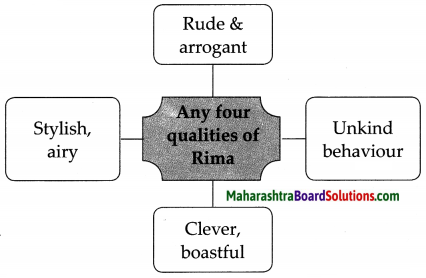
Question 2.
How did Rima and her friends try to offend Malti?
Answer:
Rima and her friends tried to. offend Malti by asking her about the oil on her hair and her long skirt.
![]()
Question 3.
Guess what Malti was about to say when the teacher entered?
Answer:
When the teacher entered, Malti was about to probably justify why she wore long skirt or oiled her hair.
Question 4.
What did Rima and her gang decide to do during the Inter-house singing competition? Did they succeed? Why?
Answer:
Rima and her gang decided to jeer when Malti sang but they did not succeed as there was such absolute silence that they did’not dare to do so. They were sure to get caught if they did
Question 5.
Why did Rima feel no joy even though she came first in her category?
Answer:
(Rima had thought that Malti must be a miserable singer and would lose in the singing competition but Malti won the first prize. Rima felt no joy even though she came first in her category as she was proved wrong and may be she even felt jealous of Malti.
![]()
Question 6.
Why did Rima walk off in a huff?
Answer:
Rima’s friends told her that she was rude to Malti. This shocked Rima as her own friends had turned against her. So, she walked off in a huff.
Question 7.
What would you have done if you would have been in Malti’s place?
Answer:
If I would have been in Malti’s place, I would have done exactly what Malti did. I would have let my work and performance speak for myself. I would have also tried to befriend Rima by helping her or praising her for her strengths.
Question 8.
Write a character sketch of Rima.
Answer:
Rima was a school-going girl who had her own clique of stylish girls. She was quick to judge people by their outward appearance. She was a bit of a snob who didn’t hesitate to comment on Malti’s oily hair. She had an envious nature as she wasn’t happy about Malti winning the first prize although she herself had also won the first prize in her own category. She thought herself to be far more superior as she was city-bred and could speak good English. She was too proud to accept her mistake when her friends pointed it out to her.
![]()
Question 9.
Discuss the meaning in the context of the story.
Answer:
- befriended (v) – became friends
- snob (n) – criticizing people coming from lower social class or are less education
- forte (n) – something one is good at
- belied (v) – failed to give a true impression or to tell lie
- smart (adj) – intelligent, clever
- confident (adj) – feeling or showing confidence in oneself or one’s abilities or qualities or being sure about ones abilities.
- insufferable (adj) – intolerable
Reading Skills, Vocabulary and Grammar
Read the following passage and do the activities.
Simple Factual Questions:
Question 1.
Fill in the blanks:
i. “Any new girls in your class?” enquired her father …………. .
ii. “She can’t speak …………. English.
Answer:
i. Mr. Sen
ii. much
![]()
Question 2.
Say whether true or false and correct in case the statement is false.
Rima can’t speak much English.
Answer:
False. Malti can’t speak much English.
Complex Factual Questions:
Question 1.
How did Rima describe Malti to her father?
Answer:
Rima described to her father that Malti was a funny girl from a state at the other end of the country who could not speak much English. She also added that Malti came with oily hair and a bindi and spoke with a strange accent.
Question 2.
Do Rima and her parents share the same attitude?
Answer:
No, Rima and her parents do not share the same’attitude. The parents confront Rima with reality. We know that because Rima’s parents defend and praise Malti when Rima criticizes her.
![]()
Vocabulary:
Question 1.
Guess the meanings of the following words in the context of the story
Answer:
- settling in (v) – to arrange oneself comfortably in
- sniffed (v) – drew in air audibly to show dislike
- mimicked (v) – imitated the voice and behaviour
- grimaced (v) – made a twisted expression on face to express disgust.
Grammar:
Question 1.
Write at least 4 Proper nouns from the above passage.
Answer:
- Rima
- Mr. Sen
- Malti
- English
![]()
Question 2.
Write at least 4 Common nouns from the above passage.
Answer:
- mother
- day
- girls
- school
Personal Response:
Question 1.
Have you ever been a victim of bullying in your class? How did you tackle it?
Answer:
Yes, I have been a victim of bullying in my class due by a handful of bullies in the class. They used to call me ‘teacher’s pet’ and tease me. Initially I was annoyed. But with the help of my parents and teachers I began to help one of the weaker students who used to bully me. In the first semester his grade were raised and he became fan and strong supporter. Eventually the others also realized their mistakes and accepted me as a friend and took my help to improve.
![]()
Question 2.
How did Rima decide whether or not Malti was smart? What is your opinion?
Answer:
Rima decided Malti’s smartness by the way she dressed and spoke English. I do not think that we should judge someone’s smartness by their outward appearance. Besides, even if someone does not speak good English, it cap always be learnt and improved upon, and the person may be very good at some other language.
Question 3.
Do Rima and her parents share the same attitude? How do we know that?
Answer:
No, Rima and her parents do not share the same opinion. We know this from the conversation between Rima and her parents. The mother feels that Malti is a clever girl for she raised her hand to answer all questions in the class. When Rima said that Malti’s English is bad and she isn’t clever, her father pointed out to Rima that the same goes with her Hindi.
Read the following passage and do the activities.
Simple Factual Questions:
Question 1.
Complete the web with the names of Rina Clique friends.
Answer:
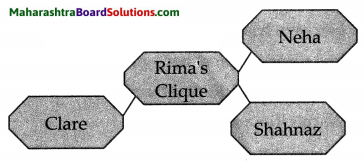
Complex Factual Questions:
Question 1.
Why was Rima sad and depressed at lunch time?
Answer:
Rima was sad and depressed at lunch time because she knew she had behaved badly with Malti but didn’t want to accept it. Besides her own friends had gone against her.
![]()
Question 2.
Which lines from the passage tell us that Malti was a very humble person?
Answer:
“I know my English is weak. Yours is good. Please, will you help me to improve it?” These lines tell us that Malti was very humble.
Vocabulary:
Question 1.
Give the antonyms of:
1. proud
2. mercilessly
Answer:
1. humble
2. mercifully, compassionately
![]()
Grammar:
Question 1.
Her own friends had turned against her.
(Separate the subject and predicate)
Answer:
Her own friends – subject
had turned against her – predicate.
Question 2.
Rima was shocked. (Transform into a question)
Answer:
Wasn’t Rima shocked?
Personal Response:
Question 1.
Is it necessary to accept one’s mistake? Why?
Answer:
Yes, it is very necessary for one to accept his mistake, because only when we accept our mistake will we make an attempt to improve ourselves. Besides, one must understand that we are all humans and are bound to make mistakes. What is important is to learn from the mistakes and not repeat them.
Language study:
Do as directed.
Question 1.
Write at least 5 common nouns and 5 proper nouns each.
Answer:
- Common nouns: parents, friends, table, participants, child, etc.
- Proper nouns: Rima, Malti, Saturday, English; Clare, etc.
![]()
Question 2.
Can you think of proper nouns that include two or more words? How are they written? Find at least ten such nouns.
Answer:
Proper nouns with two or more words have each word beginning with a capital letter except prepositions and articles.
(a) St. Peter’s Church (b) Marks & Spencer (c) The Retreat Resort (d) United Kingdom (e) Bank of Baroda (f) Big Bazaar (g) The United States of America (h) United Colours of Benetton (i) The Great Escape Water Park (j) Phoenix Market City Mall.
Question 3.
Match the meanings.
| Column ‘A’ | Column ‘B’ |
| 1. forte | a. to arrange oneself comfortably in a new place |
| 2. belied | b. to transfer |
| 3. befriended | c. to express contempt |
| 4. settling in | d. fail to give a true impression of something |
| 5. sniffed | e. intolerable |
| 6. insufferable | f. become a friend when in need of help |
| g. something one is good at |
Answer:
| Column ‘A’ | Column ‘B’ |
| 1. forte | g. something one is good at |
| 2. belied | d. fail to give a true impression of something |
| 3. befriended | f. become a friend when in need of help |
| 4. settling in | a. to arrange oneself comfortably in a new place |
| 5. sniffed | c. to express contempt |
| 6. insufferable | e. intolerable |
![]()
Question 4.
Add a suffix to any 4 words from the lesson to make their noun forms.
Answer:
- improve – improvement
- quiet – quietness
- clear – clearance
- bright – brightness
Question 5.
Make sentences using phrases/idioms.
Answer:
Question i.
To help oneself
Answer:
She placed the bowl of dessert on the table and askeci the guests to help themselves.
Question ii.
To dote on someone
Answer:
My best friend’s mother dotes on her and buys her expensive clothes.
![]()
Question iii.
To be on the verge of something
Answer:
The differences between the two countries increased so much that they were on the verge of having a war.
Question iv.
To burst into tears
Answer:
When she saw her lost child after seven days, she burst into tears.
Question v.
To walk away in a huff
Answer:
When Hera’s friends started teasing her for her new hairstyle, she walked away in a huff.
Question 6.
Discuss the difference in the meaning of the following words:
Answer:
- Smart – a clean, tidy, well-dressed person having quick-witted intelligence.
- confident – a person who believes in oneself or one abilities and qualities.
- snob – person who believes that his/her taste in a particular area is superior to those of other people.
![]()
Do as directed:
Question 1.
The teachers had liked the respectful, intelligent girl from the beginning.
(Pick out the adjectives and state their kind)
Answer:
respectful, intelligent – Adjectives of quality.
Question 2.
Malti sang beautifully.
(Pick out the verb and state whether it is transitive or intransitive)
Answer:
sang – Intransitive.
Question 3.
No one was surprised when Malti won the first prize.
(Pick out the conjunction)
Answer:
when – conjunction.
![]()
Question 4.
We put Rima into a good school to make her smart and confident.
(Pick out the preposition)
Answer:
into, to – preposition.
Question 5.
Malti answered ………………. .
(Fill in adverb of your choice to complete the sentence)
Answer:
softly, politely
Question 6.
She can’t speak much English.
(Add a question tag)
Answer:
She can’t speak much English, can she?
Question 7.
Malti looked offended but did not reply. (Replace the underlined conjunction with another conjunction without changing the meaning)
Answer:
Malti looked offended still yet did not reply.
![]()
Question 8.
Malti felt bad about their ………………….. .
(Fill in the blank with an abstract noun of your choice)
Answer:
Malti felt bad about their poverty.
Question 9.
This one does not seem smart at all.
(Change the number)
Answer:
These ones do not seem smart at all.
Question 10.
Rima did come first in her category.
(Pick out the adjective)
Answer:
first – adjective
![]()
Writing Skills:
Question 1.
Can you imagine what happened next in this story of Rima and Malti? Complete the story on your own.
The time gone by …………….
Answer:
Rima knew that she had behaved very badly. She was too proud to admit it – even to herself. Next day, after a sleepless night, Rima dragged herself to school. When she reached, her friends were already chatting with Malti. This upset her even more. Within a week or so, all her friends had befriended Malti and were all praises about her. But Rima thought otherwise.
She took it to be a wicked plan of Malti to isolate her from her friends. Rima who had always been a topper started losing confidence. This affected her performance in exams. She soon lost the affection of her teachers who thought she needed to change her rude behaviour. Rima’s health suffered and she fell sick very often. After a week’s absence from school, when she resumed, none of her friends asked her about her health.
When she asked for notes that she had missed, no one lent her the books. Rima approached the teacher and requested her to give her a week’s time to complete all the books. She also asked if she could get someone’s book to complete her notes.
The teacher send that Malti had already made notes for Rima with her permission. Rima completed all her books with Malti’s help. She was touched by this kind of gesture. She realised her mistake and apologized to Malti who embraced her. Both Rima and Malti became best of friends. Rima had learnt that beauty is skin deep.
Odd One In Summary in English
Introduction:
The lesson ‘Odd One In’ is an excerpt from the book of the same name by Tithi Tavora. Set against the backdrop of challenges encountered by a newcomer in school. The story highlights the importance of inner beauty as compared to outward appearance.
Paraphrase:
The story revolves around Rima, a city bred brat, who is quick to judge the newcomer, Malti, a countryside girl. Rima and her friends look down upon Malti for her simple looks and dressing sense. However, Malti proves her mettle to them over a period of time. Rima learns a lesson not to judge anyone by their outward appearance and be respectful to one and all. But does she really learn the lesson? Well, read the story to find more….
![]()
Glossary:
- shrugged (v) – raised the shoulders slightly and briefly as a sign that one does not care or know about something.
- grimaced (v) – made a twisted expression on the face to express disgust or pain or something hurting youth.
- mimicked (v) – imitatedl the voice and behaviour
- chorused (v) – said the same thing together
- giggled (v) – laughed in a silly way
- cattily (adv) – in a mean way
- recounted (v) – narrated
- uncharitably (adv) – in an unkind way
- atrocious (adj) – bad
- countered (v) – opposed
- snidely (adv) – rudely and critically
- abundantly (adv) – extremely
- nimble (adj) – quick
- clique (n) – a group of people who do not readily allow others to join
- exaggerated (v) – altered; to make something larger than it is.
- accent (n) – pronunciation
- countrified (adj) – unsophisticated, simple
- retort (v) – to reply in a short angry or witty manner
- jeer (v) – make rude remarks a in a loud voice
- horrid (adj) – horrible
- roundly (adv) – completely
- subdued (adj) – quiet and depressed
